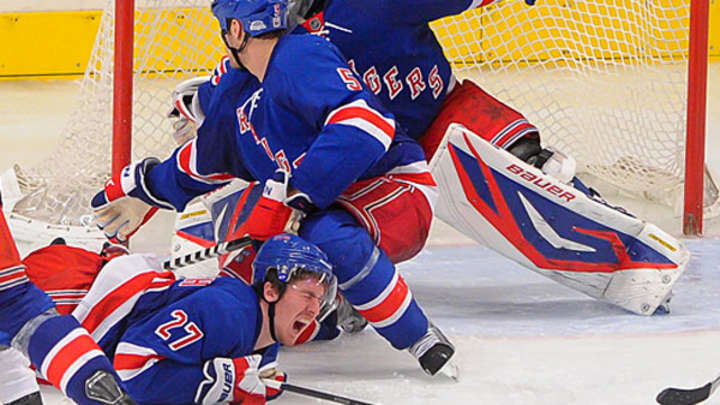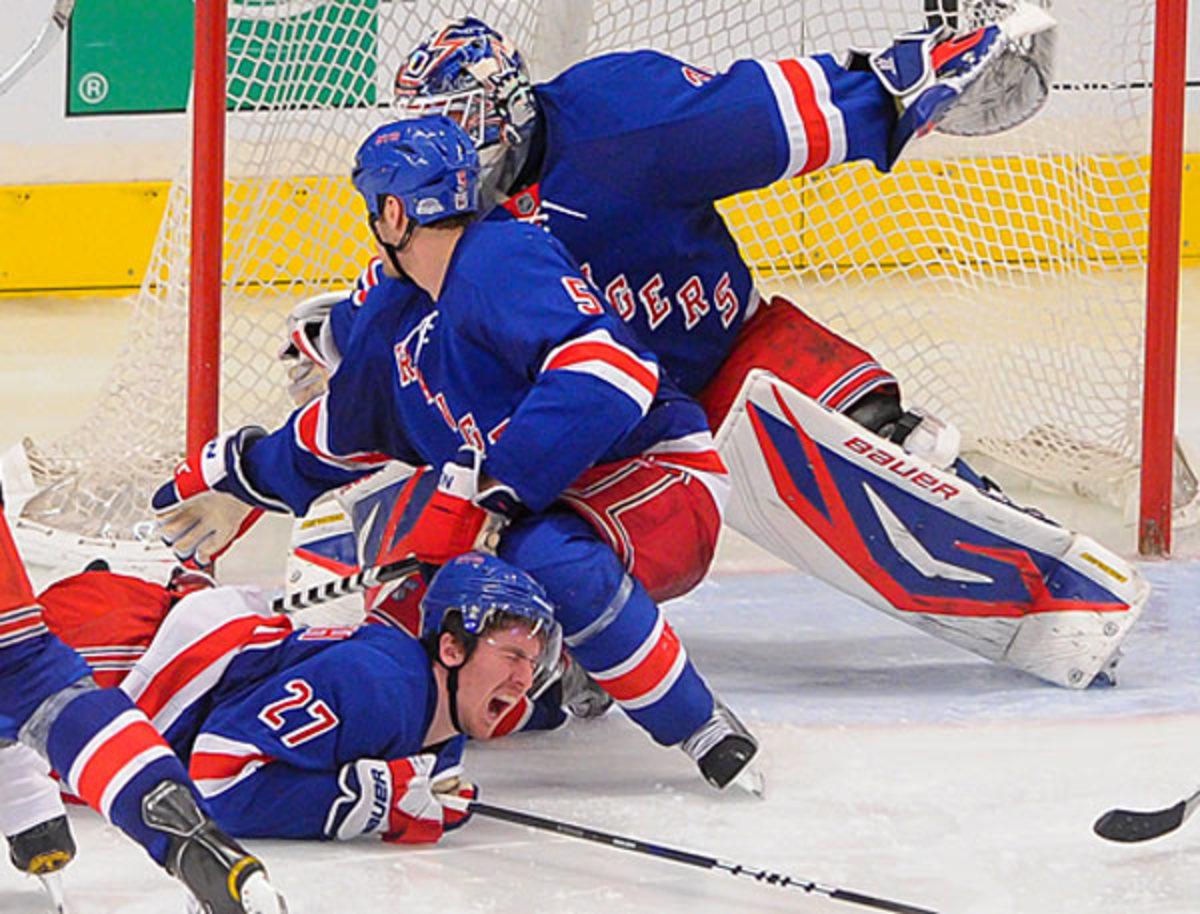Shotblocking trend draws fire

Hurts so good: Rangers defenseman Ryan McDonagh (27) takes one for his team by blocking a shot. (Bruce Bennett/Getty Images)

By Stu Hackel
Is shotblocking ruining hockey? Judging by what some commentators are saying, you'd think so. They claim it has dampened the great skill of the game's best players and diminished the entertainment factor of the playoffs. You'd also think it's the main ingredient in teams winning or losing.
The Globe and Mail, among others, seems to have become obsessed with shotblocking. Last Friday, James Mirtle noted, "In these playoffs, teams have blocked an average of 31.6 shots per game, which is one of the highest marks since the league began tracking the stat back in 1998." And he suggested, "Instead of the Dead Puck Era from just prior to the lockout maybe we can call this one the Blocked Puck Era."
Well, that doesn't seem particularly boring.
A day later, Roy MacGregor wrote in The Globe and Mail about the dominance of goaltending in the playoffs, which he acknowledged was nothing new. "What is new, however, is how the game is being played. It is so defence oriented that defencemen could check their e-mail before any opposing forward checks them. Whereas once a team might feature a single good shot blocker – hello, Bob Goldham – teams like the New York Rangers now insist on everyone trying to block every shot. The old mantra of 'Let the goalie see the puck!' has been replaced by new thinking that says it doesn’t matter if the goalie sees nothing, and if a puck should somehow get through, it will be stopped by one of two critical factors: a highly athletic goaltender’s sharp reflexes or, just as importantly, the goaltender’s size.
"And it’s working. Thirty years ago, in the scoring heyday, only rare goaltenders had a goals-against average below 3.00. This year there were dozens."
On Wednesday, The Globe and Mail's Bruce Dowbiggin went Mirtle one better and called this "the era of Robo Hockey." He characterized it by a loss of identity in which the skilled players like Alex Ovechkin are no longer permitted to display their talents and reduced to throwing their bodies in front of pucks, just like the Jay Beagles of the world.
Dowbiggin writes, "Watching the coverage on HNIC, TSN and Sportsnet, Robo Hockey would seem to be the only approved way to win a Stanley Cup now. There are no team identities, no clashes of style between Vancouver and Boston. There are no skill players dominating (Washington’s Brooks Laich mocked them with a bilious “Is Alex Kovalev skilled? Where did that get him? You know?”)....There is an impenetrable goalie. There are five well-padded bodies in front of him blocking shots. Three opposing forwards storm the net and two defenceman blaze from the point. Sometimes a shot sneaks through. Most times, there are more blocks from defenders than from the goalie. Low-scoring games typically go to overtime, connoting the notion of excitement and parity when it is instead gridlock and stalemate. Change the names and jerseys and very few would notice. The league’s Hockey Operations department wants it thus."
I don't know. That seems pretty exciting to me.
Now to Thursday. After letting its readers soak up the threat to the sport that shotblocking poses, The Globe and Mail proposed a solution courtesy of former NHL coach Pierre Pagé: a new rule modeled on basketball's three-in-the-key rule. This via Eric Duhatschek, who listened as Pagé proposed the idea during the Dead Puck Era, suggests that it be revived. "Under the Pagé plan," he writes, "hockey could create a zone in front of the goaltender that perhaps only three, or even two, players a team could enter at the same time....Let’s say the NHL designated the area from the goal to the outer edges of the lower faceoff circles as hockey’s key. If you permitted only two defenders to enter that area at a time, you might see some creative plays down low instead of the gridlock we have now....
"Maybe you’d see more stick-handling," Duhatschek adds. "Maybe you’d see more give-and-go's. It might take some getting used to – defenders stationed outside the zone, waiting for an opportunity to counter. But it might also mean more action off the rush; if a team breaks up a play in the key and gets the puck ahead to one of its forwards, it theoretically should create more open-ice, odd-man opportunities, a part of the old NHL that seems to have been relegated to the Classic TV channels.
"The attempt to unclog the area in front of the goalie would break the glassy-eyed sameness of what we have now – a game dominated by netminding and team defence, in which virtually every goal seems to come off a cycle down low and requires that the puck carom to a player in a shooting position, usually off a deflected pass. There is so much more randomness and luck involved in scoring a goal than pure offensive brilliance and it’s not because of a lack of skill. The skilled players just don’t have enough room to demonstrate those talents."
In Duhatschek's view, "What’s on display in these playoffs isn’t hockey, it’s pinball." And he goes on to wonder if shotblocking is good for the game, citing safety issues and the reduced entertainment value, noting that the five best teams in the Western Conference have been eliminated and the two left standing, the Coyotes and Kings, are defense-first juggernauts.
Once upon a time, the shotblocker was a hero, a brave individual, the crazy guy who was willing to sacrifice his body for his team. The most recent poster boy for that craziness was Ian Laperriere.
And that pretty much ended his career. If a club had a couple of players as undaunted as Laperriere, it was a bonus. The Canadiens of the late '80s, for example, had center Guy Carbonneau and defenseman Craig Ludwig. The former would time his legs-first slides perfectly, the latter had huge shinguards under his socks. They were later reunited in Dallas. But a pair of shotblockers was considered a luxury.
Now, everyone on a team -- well, at least teams like the Rangers and Capitals -- is expected to block shots. And in these playoffs, some are beginning to equate shotblocking with success. The graphics on the TV screen display the number of shots a team blocks right under the final score, and the game stories in the paper and on the internet tell the same tale while elevating this stat to prime significance. So in Wednesday night's Game 6, it was 2-1 Capitals and in almost the next breath we learn that the Caps had blocked 24 shots to the Rangers' mere 6. In the previous game, one the Blueshirts won in near-miraculous fashion with two late power play goals, Washington blocked 29, New York 19.
But do blocked shots really explain why the Caps have hung in there against the Rangers? Should this one facet of the game get so much attention? How about Rangers coach John Tortorella's unwillingness (or inability) to get his most talented line of Carl Hagelin, Brad Richards and Marian Gaborik away from the Capitals' excellent shutdown trio of Troy Brouwer, Matt Hendricks and Joel Ward? What about the Capitals figuring out that Rangers goalie Henrik Lundqvist plays so deep in his crease that he's not always able to cut off the high glove side shooting angle? Should we neglect all the minutes that Tortorella has loaded on his top defense pair of Ryan McDonagh and Dan Girardi, and on captain Ryan Callahan, as well as the toll that amount of playing time has taken on them? (In this TSN video, analyst Marc Crawford breaks down the Rangers' early penalty kill in Game 6 and shows how some sloppy play by McDonagh and Callahan led to Alex Ovechkin's game opening goal, a play that set the tone for the night).
In Game 6 on Wednesday night, Ovechkin was anything but a Robo Hockey player. He was his old dynamic self, maybe even more so. He put out a full effort, blocking shots as well finding soft spots in the Rangers' defensive zone coverage, making marvelous plays and attempting desperation shots while at full extension.
Perhaps it is Ovechkin's own Give-a-Damn quotient that has, on some nights, reduced his play to anonymity, not the demand that he block shots.
The playoffs have always been about defense. Look at the history of Stanley Cup champions and you see a list of great defensive teams. Even the run-and-gun Oilers of the '80s had to become a better club in their own end before starting to win their multiple Cup championships. MacGregor is right to say that the emphasis on shotblocking is relatively new. It arose as a result of the two-line pass returning, which rendered the neutral zone trap far less effective than before the lockout. Now teams back up and defend in their own zone. Ridding the game of clutching and grabbing also prevented defenders from wrestling down forwards in front of the net. So the best way to defend is get in the lanes and block shots.
But anyone who equates today's game with the boredom engendered by the neutral zone trap needs to have their pulse checked. True, there is a certain predictability and sameness to the way some teams play, damming the slot, keeping shooters to the outside and forcing the attacking team to pass the puck around, endlessly it seems at times, until they can find a shooting lane. But a rule restricting the movements of players would, it seems to me, be a wrench in the game's gears, transforming flow into spasm and hockey into, well, basketball. One of my least favorite rules in the NHL now is the trapezoid, precisely because it does just that -- it restricts the ability of the goaltender to play the puck. It punishes a skill. Well, shotblocking is a skill and one that encapsulates some of hockey's most revered qualities: the sacrifice for team, the courage needed to play the game at high speeds, the element of danger.
Playoff hockey isn't supposed to be pretty. It doesn't have to be ugly, as it was in the first round, but the randomness that can characterize a scoring play in the postseason, what Duhatschek called "pinball hockey" is hardly new. Playoff goals have always been the result of hard work and fighting through defenses. And the bumps, bruises and cuts that winning the Stanley Cup requires is one of the elements that makes it so difficult. Blocking shots is a big part of that. Why lose a good thing?
COMMENTING GUIDELINES: We encourage engaging, diverse and meaningful commentary and hope you will join the discussion. We also encourage, but do not require, that you use your real name. Please keep comments on-topic and relevant to the original post. To foster healthy discussion, we will review all comments BEFORE they are posted. We expect a basic level of civility toward each other and the subjects of this blog. Disagreements are fine, but mutual respect is a must. Comments will not be approved if they contain profanity (including the use of abbreviations and punctuation marks instead of letters); any abusive language or personal attacks including insults, name-calling, threats, harassment, libel and slander; hateful, racist, sexist, religious or ethnically offensive language; or efforts to promote commercial products or solicitations of any kind, including links that drive traffic to your own website. Flagrant or repeat offenders run the risk of being banned from commenting.
